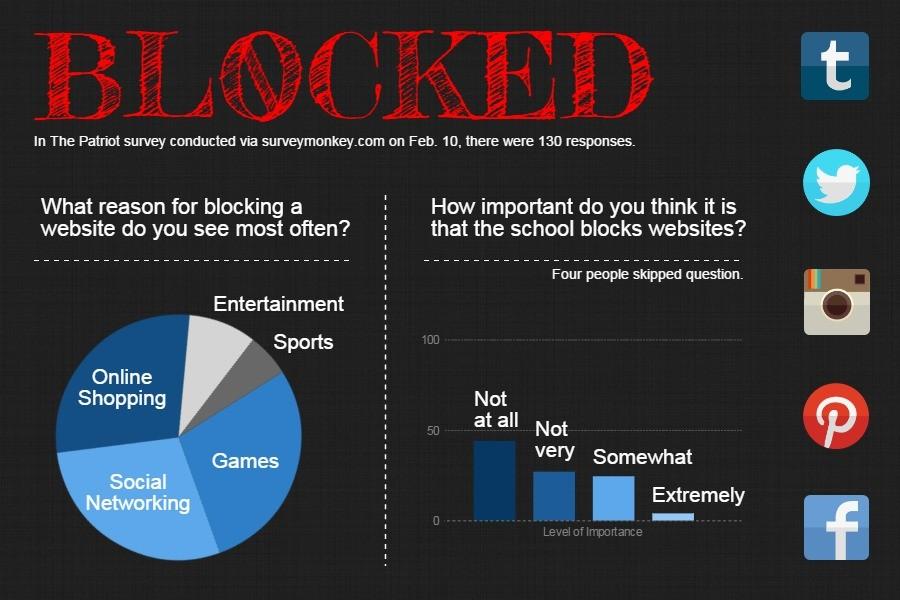Website blocking restricts students, Wireless networks improve performance
Early in the year, administration set more restrictive filters on student web browsing. Reasons for websites to be blocked include sports, entertainment, social networking, games, and online shopping.
Website blocking restricts students
An anonymous student zones out of class as she scrolls through Pinterest. The teacher’s voice is just white noise as she “pins” away. She looks at the clock and realizes that class is over.
In her next class she types the Pinterest URL to find that the website is blocked. Other fashion and social media websites are blocked too.
Students had little restrictions when it came to internet blockings. About a month ago the school implemented new restrictions that blocked almost every entertainment, sports, and shopping websites.
“The networks were too permissive. It is a balancing act of using the network for educational purposes and entertainment purposes and we can’t let entertainment outweigh education,” Vice Principal of Student Affairs & Technology Brian Powell said.
Additionally, the school has a limited bandwidth and using it for the wrong reasons degrades it. Director of Technology Greg Russell set the stricter filters which blocked the most commonly used websites students used.
A problem occurred with those students who were committing to school for sports. They were unable to go to the college’s websites for information and research. Powell reopened the sports and recreation filter so students could get to the websites, then specifically blocked the main sports websites.
When asked about teachers’ responses to Powell, he reported that no teachers have vocalized any benefits or disadvantages to him.
“With the age of the people that its aimed at and the propensity of the use, I think that it is a good thing. Students have problems figuring out why they didn’t do well on tests since they were shopping instead of learning. The problem I have is students communicating during class time,” science teacher Timothy Perry said.
“I understand why they blocked a lot of the websites. We just don’t have the bandwidth for it,” religion teacher Thomas Vierheller said.
The teachers now have their own WiFi network so they will not be affected by the blockings and slow internet speed when too many people are on at once.
Student opinions range from understanding to completely disagreeing with the new limitations.
“I don’t agree at all. The John Carroll School is supposed to be a college preparatory school. Most colleges don’t block websites, they expect you to be a responsible person, and if you choose to browse the web while your teacher is teaching that is your problem,” junior Wilfred Ikejiofor said.
While Ikejiofor disagrees, fellow classmate junior Rachel DiCamillo agrees with the blockings.
“I say I agree because it helps people stay more focused in class. The only problem I see is what if there’s a website you need to use for a project or something and it’s blocked,” DiCamillo said.
Sydney Kirwan is an In-Depth Editor for The Patriot and jcpatriot.com.
Wireless networks improve performance
At the beginning of the school year, multiple wireless networks replaced the single one that existed previously. Now, instead of having a single network, there are separate networks for faculty, administration, students, and mobile devices.
“It’s something I’d thought of from time to time, but it required some equipment upgrades we weren’t ready to do at the time,” Director of Technology Gregory Russell said. “A technology audit from an outside group gave us an extra push [to make the switch].”
According to Russell, the multiple networks act like multiple lanes on a highway, lessening the number of people in a single lane.
“It’s hard for students to tell that it’s running faster because there are still [over 600] students using that lane,” Russell said.
In addition to the lower traffic, the multiple wireless networks allow Russell to set up firewalls that only affect students and still allow teachers to access tools and websites unavailable to students. Since there are also two networks specifically for the St. Joseph Building, one for the Advancement office and one for the dorm students, dorm students have less restricted Internet access on snow days and holidays.
Although there are multiple networks, there is still only one Internet connection, which makes a bottleneck.
“My next thing to plan is to increase the speed at the Internet level,” Russell said. This step requires paying a higher fee to the Internet provider.
Kathy Deaver is the Online Chief for The Patriot and jcpatriot.com.



